This page contains the AQA GCSE Physics P15 Magnetic fields Questions and kerboodle answers for revision and understanding .This page also contains the link to the notes and video for the revision of this topic
15.1 AQA GCSE Physics P15 Magnetic Fields Kerboodle Answers : Page No. 215
1 i End X is north pole. ii End Y is south pole. b End P of a second bar magnet PQ placed near end X of bar magnet XY repels end X and attracts end Y. End P is north pole because it repel end X which is north pole and attract end Y which is south pole. The reason behind this is that like poles repel each other and unlike poles attract each other. 2 a i the N-pole of the compass needle is repelled by the tip of the nail and the S-pole is attracted by it then Tip of the nail represents N-pole. ii the N-pole of the compass needle is attracted by the tip of the nail and the S-pole is repelled by it then Tip of the nail represents S-pole. Iii the N-pole of the plotting compass is attracted by the tip of the nail and the S-pole is also attracted by it then tip of the nail is unmagnetised. b The tip of the nail in a iii attracts both poles of the plotting compass because an unmagnetised magnetic material can be magnetised by placing it in a magnetic field. The magnetic field is said to induce magnetism in the material. For example, an unmagnetised nail placed in line with a plotting compass becomes a magnet with poles at each end. The nearest poles of the nail and the plotting compass always have opposite polarity. 3 a Magnetic polarity of each end of the bar magnet represents End Y represent S-pole and end X represent N-pole. b If the bar magnet was rotated gradually about its centre through 180°, then the direction of the plotting compass reversed because a plotting compass placed in the magnetic field aligns itself along a magnetic field line, pointing in a direction away from the N-pole of the magnet and towards the magnet’s S-pole.15.2 AQA GCSE Physics P15 Magnetic Fields of electric current Kerboodle Answers : Page No. 215
1 b iron, and not steel, is used for the core of an electromagnet because iron easily get magnetised and demagnetised when current is flowing or not flowing along the solenoid. Whereas, steel is a permanent magnet and does not lose its magnetisation even when the current is switched off. Hence iron core is preferred over steel core. 3 a Reversing the current direction we should find that the plotting compass reverse its direction. b Moving the plotting compass away from the wire we should find that it point more towards magnetic north. The earth magnetic field has a bigger effect the further the compass is from the wire. This is because the strength of the magnetic field of the wire decreases as the distance from the wire increases. 4 a pattern of the magnetic field lines in and around a solenoid when there is a current in the solenoid.
 ii The further the plotting compass is from the solenoid, the less effect the solenoid has on the plotting compass. This is because the greater the distance from the solenoid, the weaker the strength of the magnetic field. On decreasing current the plotting compass turns less or less away from north pole. This is because the field has a bigger effect on the plotting compass than the earth magnetic field.
ii The further the plotting compass is from the solenoid, the less effect the solenoid has on the plotting compass. This is because the greater the distance from the solenoid, the weaker the strength of the magnetic field. On decreasing current the plotting compass turns less or less away from north pole. This is because the field has a bigger effect on the plotting compass than the earth magnetic field.
15.3 AQA GCSE Physics P15 MElectromagnets in devices Kerboodle Answers : Page No. 219
1 a A circuit breaker is a switch in series with an electromagnet-The switch is held closed by a spring. When the current is too large, the switch is pulled open by the electromagnet and it stays open until it is reset manually. b A circuit breaker is an automatically operated electrical switch designed to protect an electrical circuit from damage caused by excess current from an overload or short circuit. 2 Correct order of statements C,D,E,B,A. 3 a armature of the buzzer vibrates when the buzzer is connected to a battery because buzzer is connected to a battery, the iron armature is pulled on to the electromagnet. This opens the make-and-break switch, and the electromagnet is switched off. Because of this. The armature springs back and the make-and-break switch closes again, so the whole cycle repeats itself. b the buzzer vibrates at a higher frequency than the electric bell because it uses a similar mechanism to an interrupter bell, but without the resonant bell. They are quieter than bells, but adequate for a warning tone over a small distance, such as across a desktop. A buzzer or beeper is an audio signaling device, which may be mechanical, electromechanical, or piezoelectric. Typical uses of buzzers and beepers include alarm devices, timers and confirmation of user input such as a mouse click or keystroke. So the buzzer vibrates at a higher frequency than the bell. 4 a graph of the measurements b Conclusions based on your graph are as follows. Different weights were attached to an iron plate held by the electromagnet. The measurements in the table show the least current needed to hold the plate for each weight. For zero weight lest current required is 0.10A and as gradually we increased the weight current uniformly increased with it and making a constant graph with increased weights.
b Conclusions based on your graph are as follows. Different weights were attached to an iron plate held by the electromagnet. The measurements in the table show the least current needed to hold the plate for each weight. For zero weight lest current required is 0.10A and as gradually we increased the weight current uniformly increased with it and making a constant graph with increased weights.
15.4 AQA GCSE Physics P15 The motor effect Kerboodle Answers : Page No. 221
1 the coil of a simple electric motor rotates continuously when the motor is connected to a battery. The motor is connected to a battery. When the switch is closed, the current starts to flow and the coil becomes an electromagnet. In this case the current is flowing anticlockwise in the top of the coil. This makes the top a north pole. This north pole is attracted to the south pole on the left. So the top of the coil turns towards the left. Notice that the bottom of the coil is a south pole and is attracted to the magnet on the right. 2 a a simple electric motor connected to a battery reverses if the battery connections are reversed because most DC motors have Permanent magnets. Reversing the field of the windings will reverse the magnetic field of the rotor but the magnet will be the same, the forces between the rotor winding and the magnet will be reversed so a direction reversal results. b i if the coil was wound on a plastic block A plastic block would not – it isn’t magnetic. ii if the coil was wound on an iron block, instead of a wooden block. An iron block would help increase the magnetic field produced by the coil of wire in the motor instead of a wooden block. 3 A force is exerted on a straight wire when a current is passed through it and it is at right angles to the lines of a magnetic field. If a current carrying wire is placed within a uniform magnetic field, i such as that between the poles of a magnet, then a magnetic force Fmag is found to act on the wire. The magnetic field is a vector quantity, represented as B, and its magnitude B is called the magnetic field strength. i If we investigate how the magnitude Fmag and direction of the force Fmag change with the length l of the wire and the magnitude and direction of both the current and the magnetic field, we reach the following conclusions: The direction of the force Fmag is always perpendicular to the direction of the current and to the direction of the magnetic field B. 4 A straight wire is placed in the magnetic field of a U-shaped magnet as shown in Figure 1. The length of the wire in the field is 35 mm. When a current of 1,8 A is in the wire, a force of 0.024N acts on the wire due to the field. F = magnetic flux density, B x current, I x length, I B = 0.024/1.8*0.035 = 0.38T. 15.5 AQA GCSE Physics P15 The generator effect Kerboodle Answers : Page No. 223 1 When a wire is moved between the poles of a U-shaped magnet as shown in Figure 1, Move the wire between the poles of a U-shaped magnet and observe ammeter. We should discover that the ammeter pointer deflects as current is generated when the wire crosses through the magnetic field. This because a potential difference is induced in the wire then it crosses through the lines of the magnetic. 2 a When the magnet was then held at rest in the coil then the ammeter will have no reading. b When the coil had more turns of wire wrapped round the tube then the ammeter would flicker to a higher reading. c When the magnet is moved, its field lines are being “cut” by the coil. This generates an induced EMF in the coil that produces an induced current that flows in the coil, causing the detection in the ammeter. BUT as the magnet is NOT being moved the field lines are not being cut so no EMF is induced, so the ammeter shows no reading. So the ammeter flicker from higher reading to suddenly no reading. 3 Table 1 shows the results of testing each direction of motion of the magnet, with the magnet each way around. The table gives the direction of current round end A of the coil. Moving the coil instead of the magnet has the same effect as described in Table 1.The induced current generates a magnetic field in and around the coil, but only when the magnet is moving. As Table 1 shows, this induced magnetic field always opposes the original change.
4 In Figure 2, the tube is turned and clamped so that it is vertical with A at the top end. The bar magnet is held vertically over the top end of the tube. When the bar magnet is released, it drops down the tube and passes through the coil. Figure 2 shows a coil of insulated wire connected to a centre-reading ammeter. When one end of a bar magnet is pushed into the coil, the ammeter pointer deflects. This is because:
• the movement of the bar magnet causes an induced potential difference in the coil
• the induced potential difference causes a current, because the coil is part of a complete circuit.
In Figure 2, if the bar magnet is then withdrawn from the coil, the ammeter pointer deflects in the opposite direction. This is because the induced potential difference acts in the opposite direction, so the induced current is in the opposite direction.
Moving the coil instead of the magnet has the same effect as described in Table 1.The induced current generates a magnetic field in and around the coil, but only when the magnet is moving. As Table 1 shows, this induced magnetic field always opposes the original change.
4 In Figure 2, the tube is turned and clamped so that it is vertical with A at the top end. The bar magnet is held vertically over the top end of the tube. When the bar magnet is released, it drops down the tube and passes through the coil. Figure 2 shows a coil of insulated wire connected to a centre-reading ammeter. When one end of a bar magnet is pushed into the coil, the ammeter pointer deflects. This is because:
• the movement of the bar magnet causes an induced potential difference in the coil
• the induced potential difference causes a current, because the coil is part of a complete circuit.
In Figure 2, if the bar magnet is then withdrawn from the coil, the ammeter pointer deflects in the opposite direction. This is because the induced potential difference acts in the opposite direction, so the induced current is in the opposite direction.
15.6 AQA GCSE Physics P15 The alternating-current generator Kerboodle Answers : Page No. 223
1 a an alternating p.d. is induced in the coil because a generator contains coils of wire that spin in a magnetic field. A potential difference, or voltage, is created, or induced, across the ends of the wire when it crosses through the magnetic field lines. This process is called electromagnetic induction. b the alternating p.d. would differ if the coil is made to spin faster. The bigger the peak value of the alternating current. This is because the sides of the coil move faster and so they cross through the magnetic field lines at a transfer rate. 2 a b Reason behind this is that Both the positive and negative maximum values are called the peak value.
3 a The simplest DC generators contain an armature or coil that spins inside a rotating split-ring commutator with brushes or electrical contacts attached to generate direct current electricity. The current changes direction through the commutator, which causes the armature and loops to rotate inside the magnetic field
b
b Reason behind this is that Both the positive and negative maximum values are called the peak value.
3 a The simplest DC generators contain an armature or coil that spins inside a rotating split-ring commutator with brushes or electrical contacts attached to generate direct current electricity. The current changes direction through the commutator, which causes the armature and loops to rotate inside the magnetic field
b  4 a.c. generator in Figure 1 produces its peak potential difference when the coil is parallel to the magnetic field lines because the size of the induced potential difference is greatest when the plane of the coil is parallel to the direction of the magnetic field. At this position, the sides of the coil cross directly through the magnetic field lines. So the induced potential difference is at its peak value.
4 a.c. generator in Figure 1 produces its peak potential difference when the coil is parallel to the magnetic field lines because the size of the induced potential difference is greatest when the plane of the coil is parallel to the direction of the magnetic field. At this position, the sides of the coil cross directly through the magnetic field lines. So the induced potential difference is at its peak value.
15.7 AQA GCSE Physics P15 Transformers Kerboodle Answers : Page No. 223
1a A transformer is an electrical device that trades voltage for current in a circuit, while not affecting the total electrical power. This means it takes high-voltage electricity with a small current and changes it into low-voltage electricity with a large current, or vice versa. One thing to know about transformers is that they only work for alternating current, such as you get from your wall plugs. b i. The 2 main benefits are: The computer can be operated from the mains or from a location without a power supply .So it has improved portability. When used on the mains, if the mains fails (e.g. a power-out), you have emergency backup power (the battery). Ii Transformer Step down. 2 A step-down transformer contains a 200-turn coil and a 4000-turn coil wound on the same iron core, a coil having 4000 turns is the primary coil. b Permanent magnets are made from steel, not iron. the transformer would not work as effectively if the core was made of steel instead of iron because iron easily get magnetised and demagnetised when current is flowing or not flowing along the transformer. Whereas, steel is a permanent magnet and does not lose its magnetisation even when the current is switched off. Hence iron core is preferred over steel core. 3 a A transformer needs an alternating current that will create a changing magnetic field. A changing magnetic field also induces a changing voltage in a coil. This is the basis of how a transformer works .If dc supply is given, the current will not change due to constant supply and transformer will not work. b it is important that the coil wires of a transformer are insulated because without insulation, the path of least resistance would be straight across the coil (wire to wire to wire) rather than around the coil, through the wire. It would not create a magnetic field in the same way a coil would, making the transformer not work. 4 a For the simple construction of a transformer, you must need two coils having mutual inductance and a laminated steel core. The two coils are insulated from each other and from the steel core. The device will also need some suitable container for the assembled core and windings, a medium with which the core and its windings from its container can be insulated. Uses of transformer:- A transformer is a device that is used to either raise or lower voltages and currents in an electrical circuit. In modern electrical distribution systems, transformers are used to boost voltage levels so as to decrease line losses during transmission. b A transformer has two coils of insulated wire, both wound around the same iron core , Iron is used for the core because iron is easily magnetised and demagnetised. The coils are called the primary coil and the secondary coil, The primary coil is connected to an a.c. supply. When the alternating current passes through the primary coil, and alternating potential difference is induced in the secondary coil.15.8 AQA GCSE Physics P15 Transformers in action Kerboodle Answers : Page No. 229
1a A transformer is an electrical device that trades voltage for current in a circuit, while not affecting the total electrical power. This means it takes high-voltage electricity with a small current and changes it into low-voltage electricity with a large current, or vice versa. One thing to know about transformers is that they only work for alternating current, such as you get from your wall plugs. b i. The 2 main benefits are: The computer can be operated from the mains or from a location without a power supply .So it has improved portability. When used on the mains, if the mains fails (e.g. a power-out), you have emergency backup power (the battery). Ii Transformer Step down. 2 A step-down transformer contains a 200-turn coil and a 4000-turn coil wound on the same iron core, a coil having 4000 turns is the primary coil. b Permanent magnets are made from steel, not iron. the transformer would not work as effectively if the core was made of steel instead of iron because iron easily get magnetised and demagnetised when current is flowing or not flowing along the transformer. Whereas, steel is a permanent magnet and does not lose its magnetisation even when the current is switched off. Hence iron core is preferred over steel core. 3 a A transformer needs an alternating current that will create a changing magnetic field. A changing magnetic field also induces a changing voltage in a coil. This is the basis of how a transformer works .If dc supply is given, the current will not change due to constant supply and transformer will not work. b it is important that the coil wires of a transformer are insulated because without insulation, the path of least resistance would be straight across the coil (wire to wire to wire) rather than around the coil, through the wire. It would not create a magnetic field in the same way a coil would, making the transformer not work. 4 a For the simple construction of a transformer, you must need two coils having mutual inductance and a laminated steel core. The two coils are insulated from each other and from the steel core. The device will also need some suitable container for the assembled core and windings, a medium with which the core and its windings from its container can be insulated. Uses of transformer:- A transformer is a device that is used to either raise or lower voltages and currents in an electrical circuit. In modern electrical distribution systems, transformers are used to boost voltage levels so as to decrease line losses during transmission. b A transformer has two coils of insulated wire, both wound around the same iron core , Iron is used for the core because iron is easily magnetised and demagnetised. The coils are called the primary coil and the secondary coil, The primary coil is connected to an a.c. supply. When the alternating current passes through the primary coil, and alternating potential difference is induced in the secondary coil.AQA GCSE Physics P15 Magnetic Fields Summary questions: Kerboodle Answer Page No. 230
1 a Two bar magnets with one magnet facing North pole and other one South pole. b A plotting compass is placed in the gap at equal distance from the two magnets at a short distance from the midpoint of the gap. The Compass points will be parallel to axis of the magnets and on either side according to whether magnet with N-pole at the gap is on left or right of gap 2 When a battery is connected to the terminals the bell rings because electric current passes through the coil of electromagnet as a result of it the core got magnetised and attracts iron armature to the side. The iron armature is pulled on electromagnet and this will hit the bell. Make and break switch barriers the current through electromagnet then it loses magnetism. Now there is no attraction which causes the springs to close. Again when the switch is pressed the current passes through the coil then process repeated. 3 a i the direction of the force on side Y of the coil is upwards ii the force on each side of the coil parallel to the magnetic field lines is zero. iii forces on the coil makes coil turn. b A vertical wire is in a horizontal magnetic field of magnetic flux density 55 mT. The length of the wire in the field is 45 mm. the force on the wire when a current of 6.5 A is in the wire is calculated as follows: 0.055 T × 6.5 A × 0.045 m = 0.016 N 4 a i Accurate wave-form equal time and peak value for each half-cycle ii We will substitute the split-ring commutator by two different slip rings with connecting brush at each ring b Direct Current through the primary coil do not yield an alternating magnetic field as a result of it no potential difference generates in secondary coil as magnetic field through it does not change 5 a i the current in the cable 1000 000 W100 000 V = 10 A ii If the potential difference had been 10000V, 1000 000 W10 000 V =100 A b power is transmitted through the National Grid at a high potential difference rather than a low potential difference because more is the p.d., the less current is needed to transfer electric power. If there is low current passes through the cables, the less power wasted. 6 a the primary potential difference.Vp = 120 V × 50/ 500 V = 12 V b the current in the bulb = 60 W/120 V = 0.5 A c the current in the primary coil=for 100% efficiency VP × IP = VS × IS = 60 W IP=VS× Is /VP=60 W/ 12 V= 5 A 7 a the number of turns the secondary coil should have are nS=12 V × 3000/ 230 V = 157 turns b current through the primary coil would be if the current through the lamp is to be 3,0 A. Assume the transformer is 100% efficient. VP × IP = VS × IS 𝐼P=𝑉S× 𝐼s /𝑉P=12 V × 3.0 A/ 240 𝑉 = 0.15 AAQA GCSE Physics P15 Magnetic Fields Practice questions: Kerboodle Answer Page No. 231
01.1 A – attract B – nothing happens C – attract D – nothing happens E – repel 01.2 Complete the sentences using the correct words from the box. 01.3 A small bar magnet is suspended by thin string so that it is free to spin. The south pole of the magnet is marked. When the magnet comes to rest, the North pole of a bar magnet always points to magnetic north, so the south pole of the magnet will always point in the opposite direction to magnetic North 02.1 the copper wire is covered in insulation in order to prevent the current short-circuiting/to make sure the current flows through all the coils of wire 02.2 the alternating current produces a changing magnetic field around the coils the magnetic field interacts with the magnetic field of the permanent magnet the paper cone moves backwards and forwards the air in front of the cone produces a sound signal 02.3 The total length of the coiled wire is 20m and a current of 45 mA flows through the wire. The magnetic flux density of the magnet is 3.5×10-;T. the magnitude of the force acting on the copper wire due to the magnetic field is 0.0315 N 03.1 when a current flows through the solenoid a magnetic field is produced around the solenoid. So the soft iron armature is attracted to the solenoid. Therefore the small weight is raised off the balance 03.2 correctly labelled axes points correctly plotted straight line of best fit 03.3 weight of the small weight on the balance is 5 N 03.4 Factors that were kept constant are : armature material mass of small weight number of coils on solenoid 03.5 the independent variable is the current 03.6 dependent variable is the weight on the balance 03.7 relationship between the current through the solenoid and the magnetic field produced. As the current increases the magnetic field strength increases, they are directly proportional 04.1 ways of making the coil rotate in an anti-clockwise direction reverse the poles of the magnet, reverse the direction of current flow 04.2 Ways of increasing the force on the coil in the electric motor are as follows. By using a higher voltage battery and by using a higher strength magnetDisclaimer
Disclaimer: I have tried by level best to provide the answers and video explanations to the best of my knowledge. All the answers and notes are written by me and if there is any similarity in the content then it is purely coincidental. But this is not an alternative to the textbook. You should cover the specification or the textbook thoroughly. This is the quick revision to help you cover the gist of everything. In case you spot any errors then do let us know and we will rectify it. References: BBC Bitesize AQA GCSE Science Kerboodle textbook Wikipedia Wikimedia Commons Join Our Free Facebook Group : Get A* in GCSE and A LEVEL Science and Maths by Mahima Laroyia: https://www.facebook.com/groups/expertguidance.co.uk/ For Free Tips, advice and Maths and Science HelpThis page contains the detailed and easy notes for AQA GCSE Physics Magnetism and Electromagnetism for revision and understanding Magnetism and Electromagnetism.
Banner 1
New (9-1) AQA GCSE Physics Paper 2: Complete Revision Summary
MAGNETISM AND ELECTROMAGNETISM
Banner 2
4.7 Magnetism and Electromagnetism
- Magnetism
- Magnetic Poles
- Magnetic Fields
- Electromagnetism
- The motor effect
- Flemming Left Hand Rule
- Electric Motor
- Electric Loudspeakers
- Induced Potential
- Generator Effect
- Microphones
- Transformers
MAGNETS
Magnet has two poles. North Pole and South Pole
| Permanent Magnets – | Temporary Magnets – |
| Do not loose their magnetism | Can be magnetised and demagnetised. |
| eg: Bar Magnet | eg Iron, Steel. |

MAGNETIC FIELD
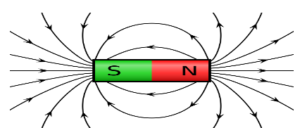
- Magnetic field in a bar magnet
- Field lines are from north pole to south pole.
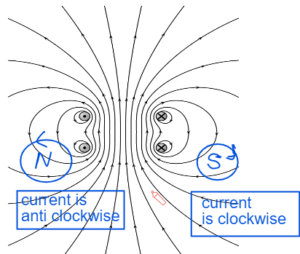
- Magnetic field in a solenoid. Solenoid is a coil of wire.
- Field are in straight line inside the solenoid and forms the loop at the end.
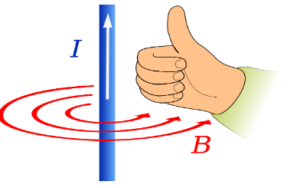
- Magnetic field in a current carrying wire
- Field lines are according to the right hand rule. Thumb points in the direction of current, the fingers give the magnetic field of line.
- If the current is upwards, the magnetic field lines is anticlockwise.
- If the current is downwards, the magnetic field lines is clockwise.
Banner 3
ELECTROMAGNETS
It is the solenoid wound around an iron core. When the current is passed through a solenoid, the iron core becomes magnetised.

CIRCUIT BREAKER
It is an electromagnet which magnetised with a large flow of current and attracts the switch towards itself turning off the current.
SCRAPYARD CRANE
It has an electromagnet which is magnetised and then attracts the scap.
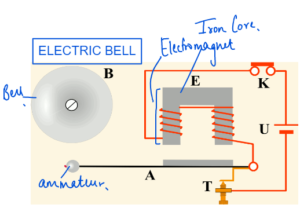
- When the switch is closed; the current flows through the electromagnet.
- The iron core will become magnetics and will attract the ammateur which rings the bell.
Banner 4
RELAY
- A small amount of current will move the current in the electromagnet making the core magnetised.
- The core will attract the iron ammateur and will close the switch gap.
- The switch will be closed and the current will start flowing in the motor.
- A small current switch on the device with a greater current.
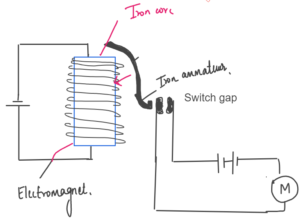
Banner 5
MOTOR EFFECT
When a current carrying wire is placed in a magnetic field, it experiences a force.
Force can be increased by :
- a) Increasing the current
- b) Taking stronger magnet
- c) Placing the coil perpendicular to the magnetic field.
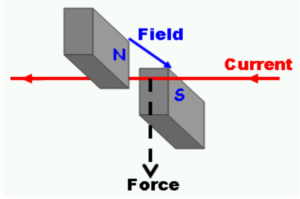
FLEMMING LEFT HAND RULE

F – Force on the conductor
B – Magnetic Flux density
I – Current flowing through the conductor
L – Length of the conductor
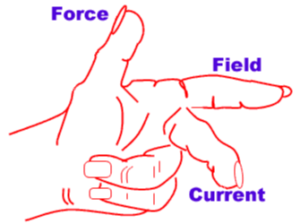
First Finger:- Magnetic Field
Center Finger: Current
Thumb: Direction of Force
When a current passes through a coil placed in a magnetic field, the coil experiences a force and starts to rotate. The direction of force is given by left hand rule.
Baneer 6
ELECTRIC MOTOR
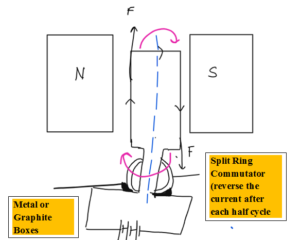
GENERATOR EFFECT
- When the magnet is moved inside and outside of the wire it produces a current in the wire due to electromagnetic induction.
- If the magnet is moved in the opposite direction the deflection is in the opposite direction
- Moving the wire or moving the coil has the same effect as both cuts the magnetic field lines.
- When the wire is connected to a built it will light up = GENERATOR EFFECT
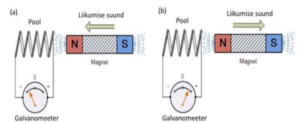
Banner 7
ALTERNATING CURRENT GENERATOR
- A coil is rotated in a magnetic field.
- Rotating coil cuts the magnetic field of lines and produces an electric current through electromagnetic induction.
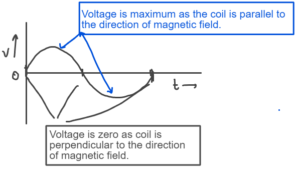
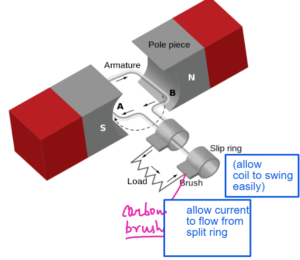
DYANAMO
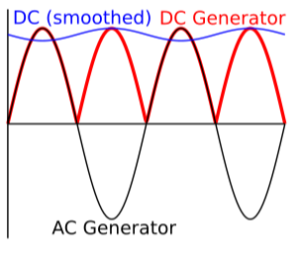
- Motor has slip ring commutator instead of slip rings
- So due to this commutator the current is not reversed so it gives only DC current.
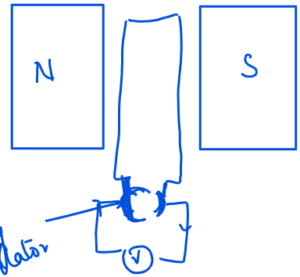
Split ring commutator
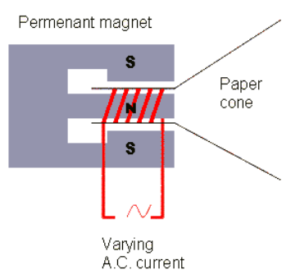
Coil of wire connected to alternating current
Current is switched on it generated a magnet field which interact with the permanent magnetic field and produces force. When the current reverses the direction of force reverses generating sound waves.
Banner 8
TRANSFORMERS
It is the device which is used to increase (step up) or decrease the voltage (step down) or the potential difference.
- Primary coil and the secondary coil is wound around the soft iron core.
- Primary coil is connected to an AC supply.
Input Voltage
- Changing Electric current in the primary coil creates a magnetic field.
- The changing magnetic field cuts along the secondary coil and produces a voltage.
Output Voltage
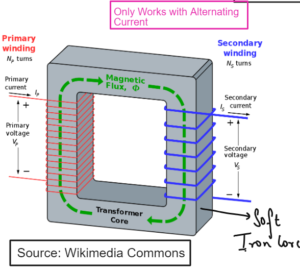
TRANSFORMER CALCULATIONS
= VP/VS=NP/NS
Vp = Voltage across primary coil
Vs = Voltage across secondary coil
Np = Number of turns in primary
Ns = Number of turns in secondary
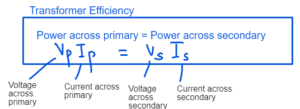
If the number of turn in primary is 20 and input voltage is 230 V, What are the number of turns in secondary if the voltage generated in secondary is 460 V?
Vp = 230V Np = 60
Vs = 460V Ns = ?
=
Ns = Np x Vs/ Vp
= 20 x 460/ 230
= 40 turns
A transformer input voltage is 230 V and the current is 20 A. What is the output voltage if the output current is 10A.
Vp = 230V Vs = ?
Ip = 20A Is = 10A
Vp x Ip = Vs x Is
230 x 20 = Vs x 10
230 x 20/10 = 460V
NATIONAL GRID
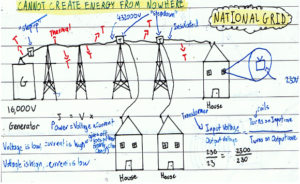
Increasing voltage for transmission increases the voltage and decreases the current High current causes heating and results in loss of energy. By increasing the voltage, current is lowered and energy loss is prevented so transmission is efficient.
H x I2
| STEP UP TRANSFORMER | STEP DOWN TRANSFORMER |
| Increase the voltage | Decrease the voltage |
| It has more turns in secondary than in primary. | It has more turns in primary than in secondary |
| Voltage in secondary is greater = Is x Ns ↑ | Voltage in secondary is lower = Is x Ns ↓ |
| Connected next to the power station to transmit high voltage to reduce the heating effects of current during transmission. | Connected to the power supply before it reaches homes to reduce the voltage to 230 V. |
Banner 9
KEY TERMS
Magnet – A magnet is a material or an object that produces a magnetic field. Magnet has two poles – North Pole and South Pole
Magnetic Field Lines – The magnetic field lines are a visual tool used to represent magnetic fields. Field lines are from north pole to south pole.
Induce Magnetism – When a piece of non-magnetized magnetic material touches or approaches the pole of a permanent magnet, it becomes a magnet in itself.
North Pole – One end of the compass needle points in the North direction and is called the North Pole of the magnet
South Pole – One end of the compass needle points in the South direction and is called the South Pole of the magnet.
Solenoid – Solenoid is a coil of wire.
Electromagnets – It is the solenoid wound around an iron core.
Relay – A relay is an electric or electromechanical switch consisting of an electromagnet, an ammateur, a spring and a set of electrical contacts.
Circuit Breaker – It is an electromagnet which magnetised with a large flow of current and attracts the switch towards itself turning off the current.
Motor Effect – Motion as a result of current in a magnetic field is called the motor effect.
Flemming Left Hand Rule – When a current passes through a coil placed in a magnetic field, the coil experiences a force and starts to rotate. The direction of force is given by left hand rule.
Magnetic Flux density – Magnetic flux density (B) is defined as the force acting per unit of current per unit of length in a cable placed at right angles to the magnetic field.
Split Ring Commutator – These are rings that allow the direct current to move in the opposite direction to maintain full rotation.
Electromagnetic Induction – It is the production of voltage or electromotive force due to a change in the magnetic field.
Generator Effect – Current is produced because of the motion of a conductor in the magnetic field. Mechanical energy is transformed to electrical energy.
Transformer – It is the device which is used to increase (step up) or decrease the voltage (step down) or the potential difference.
Step Up Transformer – It is the device which is used to increase (step up) or the potential difference.
Step Down Transformer – It is the device which is used to decrease the voltage (step down) or the potential difference.
Transformer Efficiency – Efficiency of a transformer can be defined as the output power divided by the input power.
National Grid – Electricity is transferred from the power plant to consumers via the National Grid
Banner 10
Disclaimer:
I have tried my level best to cover the maximum of your specification. But this is not the alternative to the textbook. You should cover the specification or the textbook thoroughly. This is the quick revision to help you cover the gist of everything. In case you spot any errors then do let us know and we will rectify it.
References:
BBC Bitesize
Wikipedia
Wikimedia Commons
Image Source:
Wikipedia
Wikimedia
Commons
Flickr
Pixabay
Make sure you have watched the above videos and are familiar with the key definations before trying these questions. It is also good to time yourself while doing these questions so that you can work on the speed as well.
P13- Electromagnetism
- Induced Potential, Transformers & National Grid 1 MS
- Induced Potential, Transformers & National Grid 1 QP
- Induced Potential, Transformers & National Grid 2 MS
- Induced Potential, Transformers & National Grid 2 QP
- Induced Potential, Transformers & National Grid 3 MS
- Induced Potential, Transformers & National Grid 3 QP
- Motor Effect 1 MS
- Motor Effect 1 QP
- Motor Effect 2 MS
- Motor Effect 2 QP
- Permanent & Induced Magnetism 1 MS
- Permanent & Induced Magnetism 1 QP
- Permanent & Induced Magnetism 2 MS
- Permanent & Induced Magnetism 2 QP
